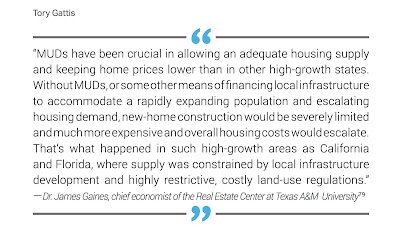The URI Next American Cities report, Texas MUDs as a model, HTX #1 for college grads and MPCs, ADUs, global housing is broken, and more
Our featured item this week is the release of our newest report from the Urban Reform Institute: The Next American Cities:
"The urban form has shifted throughout history. This has been critical to its success. Today we are on the cusp of another transition, ushered in by new technologies and changing demographics, and accelerated by a devastating pandemic. Although these forces affect all geographies, the best chance of success and growth lies in what we define as The Next American City.
This newly released report from Urban Reform Institute examines the places that offer opportunity for a revitalized American Dream for more citizens.
The Next American City offers an answer to the problem plaguing those living in and around major cities. Offering a combination of affordability, amenities, and proximity to the large cities, but without the burdensome, heavy-handed regulations of local government or many of the social ills running rampant in our cities, these places – like The Woodlands and Bridgeland – are quickly shaping up to be the urban destinations of the future."
The Kinder Institute for Urban Research at Rice University even mentioned and endorsed our report in their recent article, "After 20 years, the center of Harris County's population has moved outside the Loop":
“The Urban Reform Institute, which advocates for market-oriented city planning, recently argued that the new models for American city living are developer-designed suburb and exurb communities such as The Woodlands, Bridgeland and Cinco Ranch, and there are a lot of reasons to suggest they are right. Development ever outward will almost certainly continue, particularly in Houston where there are no constraints and plenty of land.
Adding to the expectation for further suburban expansion are the evolving norms around remote/hybrid work, meaning long commutes will be less of a drawback for some workers. Looking even further forward, technologies such as autonomous vehicles could actually encourage more sprawl, which researchers are beginning to anticipate.
The pandemic certainly accelerated this trend. Based on our estimates from USPS data, tens of thousands more Houstonians left the city than moved here in 2020, and most of the move-outs stayed in the metro area, opting to live in one of the suburbs instead.”
- Great crime reduction strategy in Dallas we can learn from
- Here’s Why California Is Losing Population for the First Time
- WSJ: Texas and Arizona, joining Idaho and Utah, have recovered all the jobs they lost at the start of the Covid-19 pandemic, thanks partly to population growth
- A new study by two CA researchers names Houston as the #1 place among the country’s 50 largest spots for college graduates to enjoy the highest standard of living: “local income is relatively high, cost of living is moderate, and there are no state taxes”
- Houston No. 1 in U.S. for home sales in master-planned communities, says survey: "According to a survey by real estate consulting firm RCLCO, 20% of the country’s 50 top-selling master-planned communities last year are in the Houston metro area. In that category, Houston ranks first among all of the metro areas represented on the list"
- Great analysis from Kinder on Houston ADUs. Reducing barriers to more is great, but they will always have a hard time competing with the amenities and scale of Houston's super-competitive apartment market.
- Bloomberg: The Global Housing Market Is Broken, and It’s Dividing Entire Countries - The dream of owning a home is increasingly out of reach. Democratic and authoritarian governments alike are struggling with the consequences. I've been arguing this for a long time: government housing constraints are popular with voters in the short-term, but come back to haunt cities long-term, which is why Houston's lack of zoning and open housing market is so important and is a critical long-term competitive advantage.
Labels: affordability, crime reduction, development, economy, growth, home affordability, land-use regulation, perspectives, quality of place, rankings, sprawl




3 Comments:
More proof of Houston's highest standard of living in the world!
Did you notice on p52 of the Cost of Living study that the most expensive cities not only had high prices but the price level was significantly higher for lower incomes than for the rich vs. Mid and lower cost cities where the levels were lower for the lower income tranch and somewhat higher for the upper income one? Houston wasn't listed. Given the "progressive" obsession with equity this would appear to be a glaring defect. "Progressive" cities favor the rich! I'm shocked, shocked I tell you!
Regards, Bill
I did! Great point. Expensive cities really hammer the working class. It did include Houston though, which did very, very well (will discuss in more depth in a future post)
https://siepr.stanford.edu/publications/working-paper/where-standard-living-highest-local-prices-and-geography-consumption
Post a Comment
<< Home